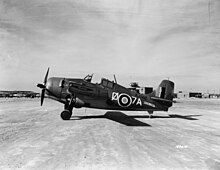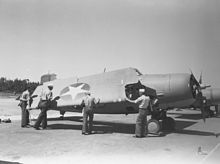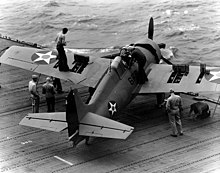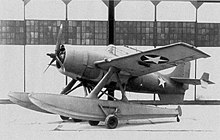Grumman F4F
| Grumman F4F / General Motors FM Wildcat | |
|---|---|
 General Motors FM-2 of the USS Santee in October 1944 |
|
| Type: | Fighter plane |
| Design country: | |
| Manufacturer: | |
| First flight: |
September 2, 1937 |
| Commissioning: |
1940 |
| Production time: |
July 1940 to May 1945 (production aircraft) |
| Number of pieces: |
7722 |
The Grumman F4F Wildcat was a carrier-based fighter aircraft operated by the United States Navy . It was the standard fighter on US Navy aircraft carriers at the beginning of World War II and carried the brunt of the fighting in the Pacific arena until the first half of 1943 . The British Fleet Air Arm also used the type on aircraft carriers of the Royal Navy under the name Martlet . The Wildcat, which was in use until 1945, is considered to be the origin of the famous "cat family" of Grumman Aerospace Corporation (Grumman-Werke), whose tradition of naming aircraft models after cat species continued until the F-14 Tomcat .
history
Emergence
In the fall of 1935, the Bureau of Aeronautics of the US Navy began looking for a powerful successor to the obsolete biplane fighters of the US Navy , as the development in the mid-1930s was dominated by fast monoplane fighter aircraft. The Grumman-Werke initially submitted the G-16 model (marine designation XF4F-1 ), a draft of a single-seater double-decker hunting plane with a more powerful Wright Cyclone radial engine based on their older model. The design competed against the XF2A-1 from Brewster Aeronautical Corporation and the XFN-1 from Seversky Aircraft Corporation , both monoplane designs. During the first months of 1936, the engineers at the Grumman Works realized that this model could not achieve the desired performance of the US Navy. Leroy Grumman therefore asked the Navy for permission to modify the design and offer a monoplane. The construction contract for the prototype of the new design (marine designation XF4F-2) was placed on July 28, 1936 under the order number 46973.
The elaboration of the design and the construction of a mock-up and a prototype lasted until August 1937, when the Grumman works presented the finished XF4F-2. The maiden flight of the prototype took place on September 2nd and was extensively tested over the next three months on the factory premises in Bethpage . During this trial, the first problems with the Pratt & Whitney R-1830 engine became apparent, which tended to overheat and break the crankshaft bearings. On December 23, the prototype was brought to Naval Air Station Anacostia , where flight testing by the Navy continued. On February 14, 1938, the machine came back to Grumman's factory, where final improvements were made. On March 1, one of the first comparison flights against the competing models took place. During a test flight on April 11th, the engine failed, so that the pilot had to make an emergency landing without a drive on a field near Philadelphia . The prototype, which overturned on landing on the soft field and was badly damaged, had to be brought back to the manufacturing plant. Due to the unreliability of the engine, the naval command decided on the Brewster F2A-1 and placed the order for the construction of 54 machines.
Despite the BurAer's decision, the Grumman-Werke continued to develop the F4F - a different engine with an improved charger fan and improved cooling should solve the problems of the first prototype. The interest of the US Navy in this new model was aroused, and the decision was made to order an XF4F-3 in October 1938 , also as a reassurance for problems with the Brewster model. The model had parts of the cell structure from its predecessor, but larger Wings and a three-bladed propeller, had its maiden flight on February 12, 1939. In the following months, the prototype was thoroughly tested by the manufacturer and the Navy, it exceeded the Brewster F2A in all values. After a few small modifications, the Grumman works received an order in August 1939 to build 54 series machines of the type F4F-3.
introduction
Before the start of series production in January 1940, France ordered 81 aircraft for its aircraft carrier Béarn . The model for France was given a different engine than the American machines due to export restrictions. The first aircraft were completed shortly before the German invasion of France ; after the defeat of France, the construction contract was canceled after only seven wildcats were completed. The British Royal Navy now showed interest in the model and took over the machines originally intended for France. When Fleet Air Arm were as Martlet Mk. I performed.
At the same time as the delivery to the Royal Navy, the introduction of the Wildcat also began in the US Navy. After reinforcement of the armament and the improvement of the engine cooling, the squadrons of the carriers Ranger and Wasp were equipped with the new fighters at the end of 1940; the first maneuvers took place in January 1941. In the summer of 1940 the number of Wildcats ordered was increased to 200 in order to be able to equip even more squadrons with the new model. In November 1940, testing of the XF4F-6 began, which, compared to the previous series machines, received a two-stage compressor and thus achieved better altitude performance. It was introduced between March and May 1941 as F4F-3A in 65 copies with both the US Navy and the Marine Corps. 30 Wildcats of this type, which were originally intended for Greece, could no longer be delivered because the country had meanwhile been occupied by the German Empire, and instead also went to Great Britain, where they were introduced as Martlet Mk. III and from the 805th and 806th Squadron in North Africa.
First operations and improvements
Two machines of the 804th Squadron of the Fleet Air Arm achieved the first aerial victory of a Wildcat on December 25, 1940 over Scapa Flow when they shot down a German Ju-88 reconnaissance aircraft.
On April 14, 1941, the XF4F-4 , the prototype of the F4F-4 , made its maiden flight. The model developed by the Grumman works from March 1940 had, compared to its predecessor model, rearward-folding wings and reinforced armament consisting of six 12.7 mm machine guns in the wings. The first F4F-4s went to the Fleet Air Arm in August 1941, the US Navy did not receive the first machines until the end of 1941, i.e. around the time the American entered the Second World War. At the time of the Japanese attack on Pearl Harbor , eight squadrons from the Navy and two from the Marine Corps were equipped with a total of 187 F4F-4s and 85 F4F-3As . The first combat mission of American Wildcats was a squadron of twelve machines of Marine Fighter Squadron 211 on Wake during the Japanese attack on the island on December 8, 1941. After the destruction of seven Wildcats on the ground, the defenders of Wake only had five machines of this type available, but achieved their greatest success with the sinking of the destroyer Kisaragi and the downing of a Japanese bomber on December 11th.
War effort
The first aerial victory of a carrier-based Wildcat was achieved on February 1, 1942 by a machine of Fighter Squadron 42 from Yorktown , which shot down a Japanese Kawanishi H6K2 flying boat near the Gilbert Islands . Almost three weeks later, on February 20th, Edward O'Hare , who was stationed on Lexington , became the first to shoot down five Mitsubishi G4M bombers under US rules that stipulated only five aerial victories for the title. Flying ace ”on the Wildcat. In the following months, the Navy's Wildcat-equipped squadrons carried the brunt of the fighting in the Pacific. During the Battle of Midway , the Battle of Guadalcanal and the Battle of the Eastern Solomon Islands , the technically inferior American aircraft were able to withstand the superior - because more agile - Japanese A6M Zero fighters through clever tactics .
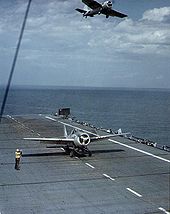
With the introduction of the successor F6F in the Grumman parent plant in the spring of 1942, production capacities became scarce, so that, at the urging of the Navy, it was decided to continue production of the Wildcat at General Motors or the newly founded subsidiary Eastern Aircraft. On April 18, 1942, GM received the building contract for 1800 machines, now designated FM-1 , which were largely identical to the F4F-4 . The first FM-1 took off on August 31, 1942, and 21 machines had been delivered to the Navy by the end of the year. In 1943 the US Navy received 818 copies, the Royal Navy 311, which they referred to as the Martlet Mk . With the replacement of the Wildcat by the more powerful F6F Hellcat in the summer of 1943, the range of applications for the aircraft shifted. They were mostly used by the US Navy from aboard the smaller escort aircraft carriers and supported amphibious landing operations and the fight against submarines.
The short flight decks of the escort carriers posed problems for the ever heavier Wildcat, so that Grumman decided to save weight on the machine in a new design. The prototype XF4F-8 , which had received a lighter engine and a larger tail unit, flew for the first time on November 8, 1942, was then examined in detail by the Navy and went into production at General Motors in early 1943 as the FM-2 . The original order was for 1,200 units, and by May 1945 4,777 machines, including 340 Martlet Mk. VIs for the Royal Navy, had been built. The FM-2 was mostly used by the US Navy in so-called “composite squadrons” together with TBM Avenger bombers to support ground troops in the Pacific and to fight submarines. The last aerial victory of a Wildcat was achieved by a pilot stationed on the USS Lunga Point on August 5, 1945. At the time of the Japanese surrender , the US Navy still had 650 Wildcats in stock, 184 of them on escort vehicles. They were quickly decommissioned; In the Royal Navy, some of the now superfluous aircraft were simply disposed of into the sea via the deck edges of the girders.
Today around 18 airworthy machines are still preserved, and several more are in various museums around the world.
technology
Airframe
The Wildcat was a typical Grumman design with a compact, barrel-shaped fuselage, wings in the middle-decker position and a narrow-gauge main landing gear that is retracted into the fuselage. The wings and the fuselage were made of all-metal construction. The shape of the fuselage was based strongly on the fuselage shape of the F3F biplane , the wings had a NACA-230 profile , which offered good coefficients of lift and drag. In later models, the wings could be folded onto the fuselage by hand to save space on board aircraft carriers. The main landing gear of the tail wheel landing gear was retracted and extended by the pilot using a hand crank.
drive
The Wildcat was powered by a turbocharged radial engine with a three-bladed propeller. Depending on the model , engines from Pratt & Whitney or Curtiss-Wright were installed. The Wright engines were used on the export models because the P&W engines were subject to strict export restrictions. The power of the engines was mostly around 1200 hp , the top speed of the Wildcat was 512 km / h.
Armament
The main armament of the Wildcat consisted of four (for the F4F-3) or six (for the F4F-4) air-cooled 12.7 mm machine guns with 240 rounds of ammunition each. In addition, drop ammunition could be carried at two lower wing stations, depending on the intended use 45 kg free-fall bombs, phosphorus , from mid-1944 also napalm bombs or three unguided 5-inch air-to-surface missiles per station.
variants
XF4F-1
First double-decker design that was not built (company name G-16).
XF4F-2
First prototype (in-house name G-18) with Pratt & Whitney R-1830-66 Twin Wasp , output 783 kW (1,050 PS). The armament of two 7.62 mm machine guns was mounted above the engine in the nose. (Bu.No. 0383 - c / n 356); First flight September 2, 1937; Conversion to the XF4F-3
XF4F-3
Also type G-36. Further development of the first aircraft with a Pratt & Whitney R-1830-76 engine with 895 kW (1200 hp) and a two-stage charger, which delivered better performance at altitudes above 3,000 meters. First flight March 2, 1939. The maximum speed was 537 km / h, the service ceiling was 10,600 meters. The armament of four 7.62 mm machine guns was in the wings.
F4F-3
The F4F-3 was the first production model and equipped with a Pratt & Whitney R-1830-76 engine . The armament was reinforced to four 12.7 mm machine guns in the wings. 288 machines were built between July 1940 and October 1941.
- Bu.No. 1844-1897 c / n 558-611
- Bu.No. 2512-2538 c / n 616-642
- Bu.No. 3856-3874 c / n 738-756
- Bu.No. 3970-4057 c / n 852-939
- Bu.No. 12230-12329 c / n 5890-5989
F4F-3A
The F4F-3A largely corresponded to the F4F-3 but was equipped with a different engine. Instead of a two-stage mechanical loader, the Pratt & Whitney R-1830-90 engine worked with a single-stage two-gear loader. As a result, the F4F-3A was not as powerful as the F4F-3, as the modified loader system had a particular effect on the altitude performance. 95 copies were built between March and May 1941. Thirty copies went to the Royal Navy as Martlet Mk. III, originally they were intended for Greece.
- Bu.No. 3875-3904 c / n 757-786 - to the RN as Martlet Mk. III
- Bu.No. 3905-3969 c / n 787-851
F4F-3S
A converted aircraft from the F4F-3 series, the Bu.No. 4038 was first flown on February 28, 1943 by test pilot F. Hank Kurt von Grumman with two Edo floats. The aircraft, which was nicknamed "Wildcatfish", was not built in series because of the low engine power and poor flight performance. The order for 100 machines was canceled, also because the pioneers of the US Navy pushed ahead with the construction of field airfields and the air domination by the aircraft carriers of the US Navy in the Pacific became more and more important.
Martlet Mk. I / II / III
Export model originally built for France and Greece with a Wright R-1820 engine. After the German occupation of France, the first 181 went to the Royal Navy as Martlet, 30 more machines on the stand of the F4F-3A, which were intended for Greece, followed in April 1941.
F4F-4
Second series model, in series production from November 1941. Equipped with a Pratt & Whitney R-1830-86 engine with 1200 hp, armament reinforced to six 12.7 mm MG, armor, self-sealing tanks and folding wings, it was delivered to the Navy from the end of 1941. However, due to the higher weight, the top speed fell to 512 km / h at 5915 m. By May 1943, 1,169 copies had been built.
Martlet / Wildcat Mk. IV
The aircraft, which were almost identical to the F4F-4 and were manufactured under the US Navy designation F4F-4B, went to the British between February and November 1942 as the Martlet Mk. IV. 220 machines were handed over under the Lend Lease Act, but FN205 to FN207 as well as FN240 and FN 241 were lost during transport. The planes were shipped with a Wright R-1820-40B engine that powered a three-bladed Hamilton standard propeller.
XF4F-6
Prototype of the F4-F3A
F4F-7
Long-range reconnaissance aircraft with fixed wings, increased fuel reserves and reconnaissance equipment. The fuel supply of 2950 liters increased the range to 5950 kilometers. 100 planned but only 21 machines built.
FM-1
General Motors took over the production of the F4F-4 from September 1942, by December 1943 909 machines for the US Navy and 311 for the Royal Navy, called Martlet Mk. V there , had been completed. Armament reduced to four MG.
XF4F-8 and FM-2
Equipped with the Wright R-1820-56, the XF4F-8 was about 240 kilograms lighter than the FM-1, which was beneficial in terms of range and climbing performance. Production of the model FM-2 began in September 1943 and lasted until May 1945. With the 340 Martlet Mk. VI for the Royal Navy, a total of 4777 FM-2 were built by Eastern Aircraft, which accounted for 40% of the total production of the Wildcat.
production
Acceptance of the Wildcat by the US Navy:
| Manufacturer | version | 1940 | 1941 | 1942 | 1943 | 1944 | 1945 | TOTAL |
|---|---|---|---|---|---|---|---|---|
| Grumman | XF4F-3 | 1 | 1 | |||||
| F4F-3 | 11 | 40 | 134 | 100 | 285 | |||
| F4F-3A | 95 | 95 | ||||||
| XF4F-4 | 1 | 1 | ||||||
| F4F-4 | approx. 144 | approx. 1024 | 1068 | |||||
| F4F-4B | 220 | 220 | ||||||
| XF4F-5 | 2 | 2 | ||||||
| XF4F-6 | 1 | 1 | ||||||
| F4F-7 | 21st | 21st | ||||||
| XF4F-8 | 2 | 2 | ||||||
| G-36A (France) | 91 | 91 | ||||||
| G-36B (UK) | approx. 54 | approx. 46 | 100 | |||||
| General Motors | FM-1 | 23 | 1037 | 1060 | ||||
| FM-2 | 400 | 3130 | 1247 | 4777 | ||||
| TOTAL | 106 | 334 | 1470 | 1537 | 3130 | 1247 | 7824 |
The USAAF lists slightly different numbers for the decrease in aircraft: 1941: 325 aircraft, 1945: 1337 aircraft, which results in an 81 higher Wildcat production figure.
Technical specifications
| Parameter | F4F-3 data | F4F-4 data |
|---|---|---|
| crew | 1 | 1 |
| length | 8.79 m | 8.76 m |
| span | 11.60 m | 11.58 m |
| height | 3.63 m | 3.62 m |
| Empty mass | 2,425 kg | 2,612 kg |
| Takeoff mass | 3,181 kg | 3,607 kg |
| drive | a Pratt & Whitney R- 1830-76 Twin Wasp (1,200 hp; 895 kW) | a Pratt & Whitney R-1830-86 Twin Wasp (1,200 hp; 895 kW) |
| Top speed | 525 km / h at an altitude of 6,400 m | 512 km / h at an altitude of 5,915 m |
| Service ceiling | 11,300 m | 12,010 m |
| largest range | 1,840 km | 1,240 km |
| Armament | four 12.7 mm machine guns , two 45 kg bombs | six 12.7 mm MG, up to 90.8 kg external release load |
literature
- Enzo Angelucci: The American Fighter. Haynes Publishing, Sparkford, Somerset 1987, ISBN 0-85429-635-2 .
- SB Barber: Naval Aviation Combat Statistics - World War II (OPNAV-P-23V No. A129). Air Branch, Office of Naval Intelligence, Washington, DC 1946.
- Eric Brown, CBE, DCS, AFC, RN .; William Green, Gordon Swanborough: Grumman Wildcat. Wings of the Navy, Flying Allied Carrier Aircraft of World War Two. Jane's Publishing, London 1980, ISBN 0-7106-0002-X , pp. 40-52.
- Marion E. Carl: Wildcat: The F4F in World War II. Naval Institute Press, Annapolis 2001, ISBN 1-55750-819-4 .
- Richard S. Then: F4F Wildcat in action, Aircraft Number 191. Squadron / Signal Publications, Carrollton 2004, ISBN 0-89747-469-4 .
- Richard S. Then: F4F Wildcat Walkaround. Squadron / Signal Publications, Carrollton 1995, ISBN 0-89747-347-7 .
- David Donald (Ed.): American Warplanes of World War II. Aerospace Publishing, London 1995, ISBN 1-874023-72-7 .
- Reno J. Francillon: Grumman Aircraft since 1929. Annapolis 1989, ISBN 0-87021-246-X , pp. 113-141.
- Frank L. Greene: The Grumman F4F-3 Wildcat. Profile Publications, Windsor 1972 (reprint from 1966).
- Bert Kinzey: F4F Wildcat in detail. Squadron / Signal Publications, Carrollton 2000, ISBN 1-888974-18-4 .
- Kit, Mister, Jean-Pierre de Cock: Grumman F4F Wildcat. Editions Atlas, Paris 1981.
- Don Linn: F4F Wildcat in action, Aircraft Number 84. Squadron / Signal Publications, Carrollton 1988, ISBN 0-89747-200-4 .
- Michael O'Leary: Grumman Cats. Osprey Publishing, London 1992, ISBN 1-85532-247-1 .
- Philips, Glen: Grumman F4F Wildcat, including Grumman Martlet Mks. I-VI, Warpaint series no.9. Hall Park Books, Church End Farm 1997.
- Tillman, Barrett :. Wildcat: the F4F in World War II. Naval & Aviation Publishing, Annapolis 1983, ISBN 0-933852-32-0 (Revised 1990, ISBN 1-55750-819-4 ).
Web links
- Grumman F4F at vectorsite.net (English)
- History of F4F (English)
- Grumman F4F at acepilots.com (English)
- Ghost of the lake (English)
Remarks
- ↑ Bert Kinzey: F4F Wildcat in detail. (P. 69) speaks of 7905, other sources speak of 7251, the number of aircraft built seems to be unclear.
Individual evidence
- ↑ Jim Winchester: Fighter Planes. Parragon Books, ISBN 1-4054-4940-3 , p. 96.
- ↑ Karl Schwarz: Cat Family. In: FlugRevue Edition: Aviation classics. 3/03, p. 11f.
- ↑ Karl Schwarz: Cat Family. P. 12.
- ↑ a b Don Linn: F4F Wildcat in action. Squadron / signal publications, p. 5.
- ↑ Karl Schwarz: Cat Family. P. 13.
- ↑ Karl Schwarz: Cat Family. P. 13f.
- ↑ Don Linn: F4F Wildcat in action. P. 7.
- ↑ see http://www.joebaugher.com/navy_serials/secondseries1.html
- ↑ Karl Schwarz: Cat Family. P. 15.
- ↑ Don Linn: F4F Wildcat in action. P. 10.
- ^ A b Karl Schwarz: Cat family. P. 16.
- ↑ Karl Schwarz: Cat Family. P. 17
- ↑ warbirdalley.com , as of November 11, 2007
- ↑ Don Linn: F4F Wildcat in action. P. 4f.
- ↑ WILDCAT ORIGINS: XF4F-2 / XF4F-3.
- ↑ AERO, issue 87, p. 2435
- ^ René J. Francillon: Grumman Aircraft Since 1929. London 1989, p. 113 ff.
- ↑ Statistical Digest of the USAAF 1946 , p. 94 ff.


